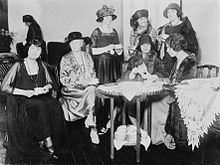National Women's Party
 |
|
| Formation | June 5, 1916 |
|---|---|
| Extinction | 1997 |
| Purpose | "To secure an amendment to the United States Constitution enfranchising women" and to pass the ERA |
| Headquarters | Washington, DC |
|
Key people
|
Alice Paul, Lucy Burns |
| Website | http://www.nationalwomansparty.org/ |
|
Formerly called
|
Congressional Union for Woman Suffrage |
The National Woman's Party (NWP) was an American women's organization formed in 1916 as an outgrowth of the Congressional Union for Woman Suffrage, which had been formed in 1913 by Alice Paul and Lucy Burns to fight for women's suffrage. The National Woman's Party broke from the much larger National American Woman Suffrage Association, which was focused on attempting to gain women's suffrage at the state level. The National Woman's Party prioritized the passage of a constitutional amendment ensuring women's suffrage throughout the United States.
The National Woman's Party, like the Congressional Union, was tightly controlled by Paul, who learned from militant suffragettes in Britain who used violence to gain publicity and force the passage of suffrage. Paul's strategy was to use publicity to hold the party in power, the Democratic Party and President Woodrow Wilson, responsible for the status of woman suffrage. Starting in January 1917, NWP members known as Silent Sentinels continued their quest for equality by protesting outside the White House.
While the British suffragettes stopped their protests when Britain entered the war in 1914, and supported the British war effort, Paul continued her campaign after the US entered the war on April 6, 1917. Members of the NWP argued it was hypocritical for the United States to fight a war for democracy in Europe while denying its benefits to half of the US population. Similar arguments were being made in Europe, where most of the allied nations of Europe had enfranchised some women or would soon.
The NWP pickets were criticized for ignoring the Great War and attracting radical anti-war elements. The pickets were later arrested on the charge of obstructing traffic, and in prison, some went on hunger strikes. Abusive treatment of the protesters, who called themselves political prisoners, angered some Americans and created more support for the suffrage amendment. They were released and their arrests were later declared unconstitutional. In the meantime, NAWSA helped pass the 1917 referendum in New York State in favor of suffrage. In early 1918, Wilson came out in favor of the amendment, and it passed the House, but failed in the Senate despite another round of protests and arrests. After the NWP helped replace anti-suffrage senators in the 1918 elections, the amendment finally passed both houses and was sent to the states for ratification. The Nineteenth amendment was ratified by enough states by 1920, thus giving women the vote.
...
Wikipedia
